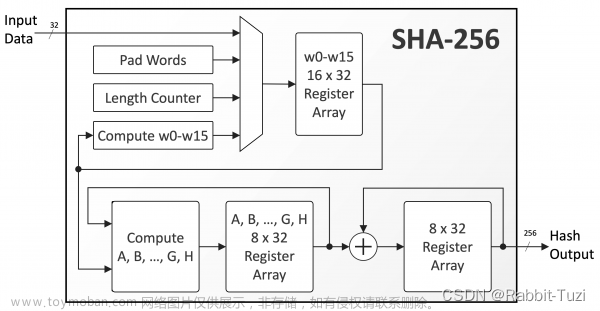一、原理
SHA-256 是一种加密哈希函数,旨在将任意大小的数据映射到一个固定大小的哈希值,通常是 256 位(32 字节)。它属于 SHA-2(安全哈希算法 2)家族,旨在提供更高的安全性。
SHA-256 的设计原则包括以下关键步骤:文章来源:https://www.toymoban.com/news/detail-854603.html
- 消息填充:输入消息的位数必须是 512 的倍数。因此,第一步是对输入消息进行填充。填充包括在消息末尾附加一个 '1',然后追加足够的零,使消息长度对 512 取模后余 448。
- 追加消息长度:填充后,将原始的 64 位消息长度追加到消息的末尾。这确保了哈希值受到消息长度的影响,增强了安全性。
- 哈希值的初始化:SHA-256 使用 8 个 32 位字作为初始哈希值。这些值是使用前 8 个素数的平方根的小数部分来设置的。
- 消息分块:对填充后的消息分为 512 位的块,每个块包含 16 个 32 位字。
- 消息调度:依次处理每个块,生成 64 个扩展的 32 位字。这些字大部分基于之前的字和哈希值,通过一系列逻辑函数和位运算计算得出。
- 压缩函数:SHA-256 使用一种包含 64 轮的压缩函数,每一轮应用不同的逻辑函数和常数。每一轮都会修改哈希值的不同部分,引入新的数据。
- 最终哈希值:处理完所有块后,最终的 8 个 32 位字被连接起来形成 256 位的哈希值。
二、C/C++实现
SHA-256.h
#pragma once
#ifndef SHA_256_H
#define SHA_256_H
#include <stdlib.h>
#include <stdint.h>
typedef struct hash_context {
uint8_t buffer[64];
uint32_t state[8];
uint32_t total[2];
} hash_context;
void hash_start(hash_context* ctx);
void hash_update(hash_context* ctx, uint8_t* input, size_t ilen);
void hash_finish(hash_context* ctx, uint8_t* output);
static void sha256_transform(hash_context* ctx, const uint8_t data[]);
#endif // SHA_256_H
SHA-256.cpp
#include <cstdint>
#include <cstdlib>
#include <cstring>
#include <vector>
#include <time.h>
#include <cstdlib>
#include "SHA-256.h"
using namespace std;
typedef unsigned int uint32_t;
typedef unsigned char uint8_t;
//typedef struct hash_context {
// uint8_t buffer[64];
// uint32_t state[8];
// uint32_t total[2];
//} hash_context;
// SHA-256 算法的宏定义
#define ROTRIGHT(word, bits) (((word) >> (bits)) | ((word) << (32 - (bits))))
#define CH(x, y, z) (((x) & (y)) ^ (~(x) & (z)))
#define MAJ(x, y, z) (((x) & (y)) ^ ((x) & (z)) ^ ((y) & (z)))
#define EP0(x) (ROTRIGHT(x, 2) ^ ROTRIGHT(x, 13) ^ ROTRIGHT(x, 22))
#define EP1(x) (ROTRIGHT(x, 6) ^ ROTRIGHT(x, 11) ^ ROTRIGHT(x, 25))
#define SIG0(x) (ROTRIGHT(x, 7) ^ ROTRIGHT(x, 18) ^ ((x) >> 3))
#define SIG1(x) (ROTRIGHT(x, 17) ^ ROTRIGHT(x, 19) ^ ((x) >> 10))
// SHA-256 常量
static const uint32_t K[64] = {
0x428a2f98, 0x71374491, 0xb5c0fbcf, 0xe9b5dba5,
0x3956c25b, 0x59f111f1, 0x923f82a4, 0xab1c5ed5,
0xd807aa98, 0x12835b01, 0x243185be, 0x550c7dc3,
0x72be5d74, 0x80deb1fe, 0x9bdc06a7, 0xc19bf174,
0xe49b69c1, 0xefbe4786, 0x0fc19dc6, 0x240ca1cc,
0x2de92c6f, 0x4a7484aa, 0x5cb0a9dc, 0x76f988da,
0x983e5152, 0xa831c66d, 0xb00327c8, 0xbf597fc7,
0xc6e00bf3, 0xd5a79147, 0x06ca6351, 0x14292967,
0x27b70a85, 0x2e1b2138, 0x4d2c6dfc, 0x53380d13,
0x650a7354, 0x766a0abb, 0x81c2c92e, 0x92722c85,
0xa2bfe8a1, 0xa81a664b, 0xc24b8b70, 0xc76c51a3,
0xd192e819, 0xd6990624, 0xf40e3585, 0x106aa070,
0x19a4c116, 0x1e376c08, 0x2748774c, 0x34b0bcb5,
0x391c0cb3, 0x4ed8aa4a, 0x5b9cca4f, 0x682e6ff3,
0x748f82ee, 0x78a5636f, 0x84c87814, 0x8cc70208,
0x90befffa, 0xa4506ceb, 0xbef9a3f7, 0xc67178f2
};
函数声明
//void hash_start(hash_context* ctx);
//void hash_update(hash_context* ctx, uint8_t* input, size_t ilen);
//void hash_finish(hash_context* ctx, uint8_t* output);
//static void sha256_transform(hash_context* ctx, const uint8_t data[]);
static void sha256_transform(hash_context* ctx, const uint8_t data[]) {
uint32_t a, b, c, d, e, f, g, h, i, j, t1, t2, m[64];
for (i = 0, j = 0; i < 16; ++i, j += 4)
m[i] = (data[j] << 24) | (data[j + 1] << 16) | (data[j + 2] << 8) | (data[j + 3]);
for (; i < 64; ++i)
m[i] = SIG1(m[i - 2]) + m[i - 7] + SIG0(m[i - 15]) + m[i - 16];
a = ctx->state[0];
b = ctx->state[1];
c = ctx->state[2];
d = ctx->state[3];
e = ctx->state[4];
f = ctx->state[5];
g = ctx->state[6];
h = ctx->state[7];
for (i = 0; i < 64; ++i) {
t1 = h + EP1(e) + CH(e, f, g) + K[i] + m[i];
t2 = EP0(a) + MAJ(a, b, c);
h = g;
g = f;
f = e;
e = d + t1;
d = c;
c = b;
b = a;
a = t1 + t2;
}
ctx->state[0] += a;
ctx->state[1] += b;
ctx->state[2] += c;
ctx->state[3] += d;
ctx->state[4] += e;
ctx->state[5] += f;
ctx->state[6] += g;
ctx->state[7] += h;
}
void hash_start(hash_context* ctx) {
ctx->state[0] = 0x6a09e667;
ctx->state[1] = 0xbb67ae85;
ctx->state[2] = 0x3c6ef372;
ctx->state[3] = 0xa54ff53a;
ctx->state[4] = 0x510e527f;
ctx->state[5] = 0x9b05688c;
ctx->state[6] = 0x1f83d9ab;
ctx->state[7] = 0x5be0cd19;
ctx->total[0] = 0;
ctx->total[1] = 0;
}
void hash_update(hash_context* ctx, uint8_t* input, size_t ilen) {
size_t fill;
uint32_t left;
if (ilen == 0)
return;
left = ctx->total[0] & 0x3F;
fill = 64 - left;
ctx->total[0] += (uint32_t)ilen;
ctx->total[0] &= 0xFFFFFFFF;
if (ctx->total[0] < (uint32_t)ilen)
ctx->total[1]++;
if (left && ilen >= fill) {
memcpy((void*)(ctx->buffer + left), input, fill);
sha256_transform(ctx, ctx->buffer);
input += fill;
ilen -= fill;
left = 0;
}
while (ilen >= 64) {
sha256_transform(ctx, input);
input += 64;
ilen -= 64;
}
if (ilen > 0) {
memcpy((void*)(ctx->buffer + left), input, ilen);
}
}
void hash_finish(hash_context* ctx, uint8_t* output) {
uint32_t last, padn;
uint32_t high, low;
uint8_t msglen[8];
high = (ctx->total[0] >> 29) | (ctx->total[1] << 3);
low = (ctx->total[0] << 3);
msglen[0] = (uint8_t)(high >> 24);
msglen[1] = (uint8_t)(high >> 16);
msglen[2] = (uint8_t)(high >> 8);
msglen[3] = (uint8_t)(high);
msglen[4] = (uint8_t)(low >> 24);
msglen[5] = (uint8_t)(low >> 16);
msglen[6] = (uint8_t)(low >> 8);
msglen[7] = (uint8_t)(low);
last = ctx->total[0] & 0x3F;
padn = (last < 56) ? (56 - last) : (120 - last);
hash_update(ctx, (uint8_t*)"\x80", 1);
hash_update(ctx, (uint8_t*)(msglen + 1), padn - 1);
hash_update(ctx, msglen, 8);
for (int i = 0; i < 8; i++) {
output[i * 4] = (uint8_t)(ctx->state[i] >> 24);
output[i * 4 + 1] = (uint8_t)(ctx->state[i] >> 16);
output[i * 4 + 2] = (uint8_t)(ctx->state[i] >> 8);
output[i * 4 + 3] = (uint8_t)(ctx->state[i]);
}
}
/************************** 宏定义 **************************/
//#define DATA_SIZE 1073741824
#define DATA_SIZE 1073741824ULL // 将数据大小定义为 unsigned long long
#define ROUNDS 1ULL // 将循环次数定义为 unsigned long long
int main()
{
hash_context ctx;
uint8_t hash[32]; // SHA-256 输出长度为 32 字节
clock_t start, end;
// 初始化随机数生成器
srand(static_cast<unsigned int>(time(NULL)));
uint8_t* data = (uint8_t*)malloc(DATA_SIZE); // 分配数据缓冲区
// 生成随机数据填充到 data 数组中
for (unsigned long long i = 0; i < DATA_SIZE; i++) // 使用 unsigned long long
{
data[i] = rand() & 0xFF;
}
// 开始计时
start = clock();
for (unsigned long long i = 0; i < ROUNDS; i++) // 使用 unsigned long long
{
hash_start(&ctx);
hash_update(&ctx, data, DATA_SIZE);
hash_finish(&ctx, hash);
}
// 结束计时
end = clock();
// 释放分配的内存
free(data);
// 计算总运行时间和每秒处理的数据量
double time = (double)(end - start) / CLOCKS_PER_SEC;
double computing_speed = (DATA_SIZE * ROUNDS * (unsigned long long)8 / 1000 / 1000) / time;
printf("运行时间: %f seconds\n", time);
printf("运算速度: %f Mbps\n", computing_speed);
return 0;
}
三、运行结果
 文章来源地址https://www.toymoban.com/news/detail-854603.html
文章来源地址https://www.toymoban.com/news/detail-854603.html
到了这里,关于SHA-256算法的原理与C/C++实现的文章就介绍完了。如果您还想了解更多内容,请在右上角搜索TOY模板网以前的文章或继续浏览下面的相关文章,希望大家以后多多支持TOY模板网!





![[虚幻引擎插件说明] DTSha – 蓝图SHA加密节点, SHA1, SHA224, SHA256, SHA384, SHA512加密](https://imgs.yssmx.com/Uploads/2024/02/604369-1.png)



